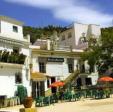| Essential Sayalonga Information | Local Businesses in Sayalonga | Sayalonga Bars & Restaurants |
Sayalonga Photos |
Sayalonga History
 Although it is near the coast, the terrain within the municipal boundaries of Sayalonga is more characteristic of the inland regions of La Axarquía, with mountains that are steep and rugged but not very high. The highest point in the municipality is La Rábita (672 meters), followed by the peak of El Mercado (638 meters), in the outlying township of Corumbela.
Although it is near the coast, the terrain within the municipal boundaries of Sayalonga is more characteristic of the inland regions of La Axarquía, with mountains that are steep and rugged but not very high. The highest point in the municipality is La Rábita (672 meters), followed by the peak of El Mercado (638 meters), in the outlying township of Corumbela.
The rivers that cross these lands are short and seasonal, due to the level of rainfall in the region. The River Sayalonga runs from north to south and upon leaving this municipality takes the name Algarrobo, while the River Güi, also known as the Huit, runs through the eastern part. Both receive the waters from several tributaries but these only have a small flow during the rainy months.Despite the diminutive area of the municipality (a little more than 18 square kilometres), Sayalonga has both a separate village, Corumbela, in its northern part that takes up 20 per cent of the municipal territory and the curious outlying hamlet of Carraspite in the south, which is made up of a good number of small farmhouses that are only occupied between August and September during the season of greatest agricultural activity.
The origin of Sayalonga is undoubtedly Arabic, but it is not known at what moment in history it began to take shape as a town, and the meaning of the name is equally a mystery; some studies support the theory of its Roman or Visigothic origins. Historical records on the locality begin to appear beginning with its surrender to the Christian troops as a consequence of the fall of Vélez, in order to prevent bloodshed that would have been useless in view of the strength of the Catholic Monarchs’ army against the ever-weakening Muslim resistance.At one time, the modern outlying district of Corumbela played a greater historic role than Sayalonga, and even the farm community of Batarxis, of which today only traces remain to show its location, is more often mentioned in chronicles than the main population centre of the municipality.
In any event, the Moors of this entire region took a very active part in the uprising that ended in the famous battle of Frigiliana.The so-called Andalusia Earthquake (25 December 1884) also damaged Sayalonga, but in contrast to other towns in La Axarquía, there was no loss of human life here.
 |
 |
 |
| Surface Area: | 18.2 square kilometres |
| Population: | about 1,300 |
| What the natives are called: | Sayalonguinos. Nickname: Sayones |
| Monuments: | Santa Catalina parish church, San Antón chapel, San Pedro church with its Mudéjar minaret (Corumbela), the circular cemetery |
| Geographical Location: | in the La Axarquía region. The centre of the town is 360 meters above sea level. It is 38 kilometres from the capital of Málaga and 12 from Vélez Málaga. The average annual rainfall is 620 litres per square metre and the average temperature is 18º C |
| Tourist Information: | Tourism Office, 2 Constitución Plaza (29752) |
| Telephone: | 952 535 206; Fax: 952 535 206 |
Indeed, the white of the town’s buildings juts out against a landscape that is overlooked by the great heights of the Tejeda and Almijara mountain ranges and stretches out in quest of the Mediterranean over a hilly country covered with the grapevines that yield its famous wine. One of the most representative images that the visitor will retain of La Axarquía will certainly be that provided by this municipality.
This is a municipality that, like so many others of the province of Málaga, has no documented history until the fifteenth century, but considering the characteristics of the territory-abundant water, mountain refuges, pleasant temperatures and its status as a link between the provinces of Granada and Málaga-it seems probable that it contained human settlements in prehistoric times. At this time, though, there are no archaeological finds to support this hypothesis.Cómpeta appears by name in written records for the first time in 1487, when the corregidor (magistrate) of Vélez, which by then was in the hands of the Christians, urged the population to submit to the new owners. This indicates that until that date the place must have been no more than a farming community.The Moriscos (Moors) of Cómpeta, like most of those in La Axarquía, joined those that had already risen up and established strongholds in Peñón de Frigiliana –a place that was linked in the sixteenth century and ever afterwards to the history of La Axarquía by the part it was to play- until the Christian troops overcame the Moorish resistance on 12 June 1569.
Although there were numerous casualties among the defenders, some escaped and continued to harass the Christians wherever they least expected it, but not for very long.The town was practically abandoned and was repopulated by long-time Christians from Puente Genil, Estepa, Baena, Seville and other localities that had already been retaken from the Muslims. The document from the first marriage contracted between established Christians in the town is preserved in the parish church. The year was 1573.



















